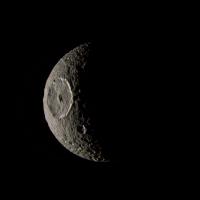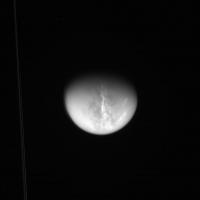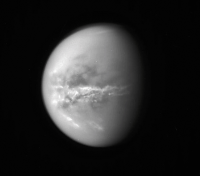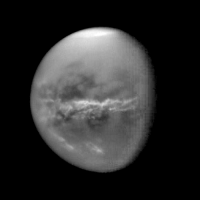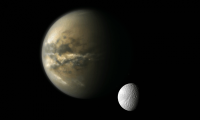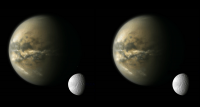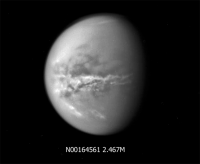Printable Version of Topic
Click here to view this topic in its original format
Unmanned Spaceflight.com _ Cassini's ongoing mission and raw images _ Rev 139 - Oct 4-28, 2010
Posted by: ngunn Oct 5 2010, 09:36 PM
Images are flowing from Cassini again following conjunction. Here's the ususal handy guide for the next few weeks:
http://www.ciclops.org/view/6570/Rev139
Posted by: jasedm Oct 5 2010, 09:53 PM
Titan, Mimas, Pallene, Dione and Rhea imaging plus atmospheric occultations etc etc - fabulous use of the resources available. I'm in awe.
Posted by: ugordan Oct 18 2010, 04:37 PM
Rev 139 images have started coming in. Hi-res http://saturn.jpl.nasa.gov/photos/raw/rawimagedetails/index.cfm?imageID=229087 and http://saturn.jpl.nasa.gov/photos/raw/rawimagedetails/index.cfm?imageID=229119 stuff. Mimas http://saturn.jpl.nasa.gov/photos/raw/rawimagedetails/index.cfm?imageID=228940.
Also, Pallene! The good news is it's in the frame and looks good, the bad news is the raw contrast stretch http://saturn.jpl.nasa.gov/photos/raw/rawimagedetails/index.cfm?imageID=228976. I'm pretty shocked at how spherical the thing looks.
Posted by: volcanopele Oct 18 2010, 06:48 PM
Keep in mind that you are basically looking down the barrel of Pallene if you will. The long axis of the satellite is pointed at Saturn, so it could be more elongated that what you see, but you are looking down the long axis.
So it may not be that circular.
Posted by: ugordan Oct 18 2010, 06:51 PM
Yeah, I was just thinking how we already had a somewhat good view (in color, too) of a rock that turned out to be ellipsoidal. Was it also Pallene or Methone, I forget? If it was Pallene, it's not surprising we'd be looking down the "barrel" - given the tidal force and particular image geometry.
Posted by: jasedm Oct 18 2010, 07:40 PM
I too am a tad disappointed by the Pallene coverage. Gordan you posted a version of Pallene based on the PDS data some time back, from images taken at (guesstimated) 67,000km, showing the moon as markedly ellipsoidal.
It seems certain that today's views have imaged the long axis as Jason states.
I was hoping for a ridge, or perhaps a large crater or two - never mind, we can't have it all.
Looking through the encounter distances for the remainder of the mission throws up a flyby at around 26,000km in September next year. This would yield images in the order of 36 pixels across. Hopefully some 'pointing time' can be allocated by mission planners in order to gain another image set of the moon at this time. Very high phase angle at c/a though....
Posted by: ugordan Oct 18 2010, 07:57 PM
Hey, I'm not disappointed. Who knows what detail lies there in the original raw frames
Posted by: Juramike Oct 19 2010, 12:01 AM
HiPassLRGB(GRN polarization 0,60,120) image of Mimas. Since the normal color images were chopped, I loaded the GRN polarization data into the RGB channels and fiddled with it to look "good". (Amping up the saturation)
Further details on flickr.
Posted by: antipode Oct 19 2010, 06:04 AM
Hmmmm, what do people make of the curving ridge running from the rim of Herschel to the limb? I dont remember seeing that before... ![]()
P
Posted by: Astro0 Oct 19 2010, 10:11 AM
Pretty spectacular display in the rings! ![]()
Original image and description http://saturn.jpl.nasa.gov/photos/raw/rawimagedetails/index.cfm?imageID=228935.
Posted by: ilbasso Oct 19 2010, 01:07 PM
P
Looks to me like the rim of an old crater that Herschel is superimposed upon. If you follow it from upper left, imagine it continuing under Herschel, and then turning back to the left, the ridge immediately at 9:00 from Herschel appears to be part of the same feature. That could be an optical illusion, coincidence, or wishful thinking. The ridge at 9:00 could just as easily be associated with the ridge line at 7:00.
Posted by: ElkGroveDan Oct 19 2010, 02:23 PM
A sequence of that perspective would have made an awesome animation but that's the best of only three.
Posted by: ugordan Oct 20 2010, 07:47 AM
It looks like a whole 'nuther moon! That stuff is visible not only in the red, but also the green filter!
Posted by: remcook Oct 20 2010, 08:04 AM
Holy cow!
Posted by: charborob Oct 20 2010, 12:16 PM
Nice shot of Titan and Tethys (?): http://saturn.jpl.nasa.gov/multimedia/images/raw/casJPGFullS64/N00164575.jpg
Part of a sequence that would make a nice animation (hint, hint).
Titan is darker than usual on this image. What would be the reason for that?
Posted by: ugordan Oct 20 2010, 12:22 PM
One of the Cassini Scientist for a Day observations, though I'll admit I was expecting to see Enceladus in the last frames.
Tethys is about the same brightness in all 3 filters while Titan darkens with shorter wavelengths. Also at this phase angle ice is still significantly brighter than the atmosphere. At high phase angles the situation would be reversed.
Posted by: Juramike Oct 20 2010, 02:02 PM
HiPassLRGB image of Dione taken October 18, 2010. HiPass and Luminance layers both used the BLU filter channel. Colors tweaked to get "close" to Planetary Photojournal image PIA07744 and some of Gordan's images.
Posted by: pat Oct 20 2010, 02:08 PM
Part of a sequence that would make a nice animation (hint, hint).
Titan is darker than usual on this image. What would be the reason for that?
The images are exposed for Tethys/Enceladus rather than Titan. As ugordon has said these are part of a "Scientist for a Day" observation, the main concern was to make sure Tethys/Enceladus didn't saturate.
Posted by: pat Oct 20 2010, 02:47 PM
The full observation doesn't seem to have hit the ground yet, there are only 29 frames out of a planned 65. I'm hoping the rest of the data is in Thursday's downlink. It would be a shame if it arrived during the ~25 min power outage at the DSN dish that was being used for yesterday's downlink -- if thats the case its gone, never to be seen.
Posted by: ugordan Oct 20 2010, 03:01 PM
Well, 30-ish frames in 25 mins sounds about right... One can still hope.
Posted by: pat Oct 20 2010, 03:20 PM
Actually I've dug deeper and the "dark" Titan is mainly down to another cause. Its the automatic compression applied to the raw images again. While Titan is the only thing in the frame the image gets scaled using the brightest Titan pixel as the reference, as soon as Tethys enters the frame its the brightest Tethys pixel thats the top reference. Also this whole observation was done in 12 rather than 8-bit which makes the difference even more dramatic. So you start with an apparently bright Titan and then Titan is much darker as soon as Tethys enters the frame (Tethys being significantly brighter than Titan).
Posted by: ugordan Oct 20 2010, 03:46 PM
Ahh, so the entire observation (including the CB3 with the awesome cloud) is linear, no LUT encoding? Useful bit of info, thanks
Posted by: ugordan Oct 20 2010, 04:58 PM
Mid-transit composite. Titan's disc is actually from earlier on, when there was no Tethys in the frame so better s/n ratio in the jpegs was available.
No alien bases were harmed during production of this image.
A ratio of CB3/BL1 frames:
I wonder how familiar a sight it would be to stand there on Titan's surface and look up at those clouds.
Posted by: elakdawalla Oct 20 2010, 05:31 PM
Gordan, when I look at the frames from earlier in the sequence you can actually see that huge band of clouds in the red filter image and even, to a limited extent, in the green. If you used those images to make the color for Titan, why isn't the band of clouds showing up?
Posted by: Phil Stooke Oct 20 2010, 05:40 PM
The brightest horizontal stripe does appear to be there, it's just so faint due to the low contrast.
(EDIT-yes indeed, if you do a high pass filter and a contrast stretch of that the clouds are there)
Phil
Posted by: ugordan Oct 20 2010, 05:50 PM
Primarily because those raw images are contrast-enhanced due to you viewing them on a sRGB screen and they were uncorrected for that. The effect is most pronounced when Cassini returns 12 bit DNs without LUT encoding. That's what Pat was talking about. The 8bit LUT encoding employs a square-root encoding which is nonlinear and is somewhere inbetween 12 bit and gamma-correct nonlinearity of the sRGB colorspace. Had the same images been encoded onboard using the LUT table, you'd see them as having lower contrast in these raws.
I merely applied a gamma correction, knowing the source raws were in fact linearly encoded (so similar to what you'd get with calibrated I/F data). Had I not done so, this is what the result would look like:
Posted by: elakdawalla Oct 20 2010, 06:23 PM
Thanks for the explanation -- it's funny what seems so prominent in one filter just goes away (from view with one's own eyes anyway) once you've done the color processing. In a way, an argument for why spacecraft need this monochrome detector/filter wheel arrangement to reveal what's going on.
Posted by: ugordan Oct 20 2010, 06:25 PM
Yes, the clouds are fairly inconspicuous even in that second version both because Titan is darker than Tethys and also because most of the visible energy picked up by the eye is in the green range, and that is where the clouds already start to fade from view.
Posted by: ngunn Oct 20 2010, 10:16 PM
Why is it that I actually prefer that one? It's a subjecive thing I suppose. It makes me feel present in a way that the other version doesn't and I have no idea why. Anyhow I just want to congratulate and thank everybody on the Cassini team including the scientist for the day for these wonderful views of the changing weather.
Posted by: ugordan Oct 20 2010, 10:31 PM
Because from what I gather from you, your monitor brightness is set so high that that one actually might look like it's supposed to!
Posted by: titanicrivers Oct 21 2010, 08:33 AM
Location of clouds over the anti-Saturn hemisphere. N00164561 CL1 CB3 image enhanced via unsharp mask and compared to the Solar System Simulator view of Titan from Cassini at 2.46M km on October 18th. Celestia grid shows many of the clouds are in the southern hemisphere especially along the southern equatorial zone. Amazing images!
Posted by: ugordan Oct 22 2010, 11:12 AM
Woohoo! The rest of the http://saturn.jpl.nasa.gov/photos/raw/rawimagedetails/index.cfm?imageID=229263 observation is down on the ground. This is going to make a great movie.
Also, another http://saturn.jpl.nasa.gov/photos/raw/rawimagedetails/index.cfm?imageID=229292 with Dione and then both http://saturn.jpl.nasa.gov/photos/raw/rawimagedetails/index.cfm?imageID=229310 behind Saturn's night side. What I wouldn't give for the 3-filter sets to be taken instantaneously for this one...
Posted by: ugordan Oct 22 2010, 09:50 PM
Some eastward motion of the clouds is noticeable in this two-frame flicker gif combining the previous CB3/BL1 and (3xCB3)/MT1 taken several hours later.
I don't think it's a parallax effect as the subspacecraft point appeared to not move much judging by lack of terrain feature rotation (don't use the limb as a reference because it's not the real limb but an arbitrary cutoff where low source S/N after division caused ugly artifacts).
Posted by: titanicrivers Oct 23 2010, 10:02 AM
Neat animation Gordon
And here's a scene that can only be seen through Cassini's camera eyes! The image on the bottom is a 3D ... yep another eye-crosser.
Posted by: scalbers Oct 23 2010, 06:26 PM
What a nice animation! Speaking of familiarity (as per Emily earlier) reminds me a bit of the Intertropical Convergence Zone on Earth.
http://upload.wikimedia.org/wikipedia/commons/1/12/IntertropicalConvergenceZone-EO.jpg
As per this modeling story (and paper), the ITCZ on Titan would be just temporarily over the equator, moving seasonally in latitude much more than on Earth. Does this match the chronology of the cloud latitudes we've seen so far?
http://chronicle.uchicago.edu/070920/titan.shtml
http://www.pnas.org/content/103/49/18421.full
The continuity over long distances of the clouds and their motion doesn't seem to look quite as convective compared with the terrestrial example though, at least from this distant view.
So what's the weather over Huygens right now. Will it be set afloat?
Posted by: titanicrivers Oct 24 2010, 07:52 AM
Here's another look at the eastward cloud motion on Titan on Oct 18. The animation compares N00164561 taken at 14:40 from 2.467M km with one (N00164618) taken 1 hr and 45 min later from 2.497M km. Change in image size has been compensated for and surface features (Bazaruto facula and Elba facula) used a fixation points. Parallax error due to Titan orbital and spacecraft motion should be small and not account for the cloud shift I would think.
Powered by Invision Power Board (http://www.invisionboard.com)
© Invision Power Services (http://www.invisionpower.com)

